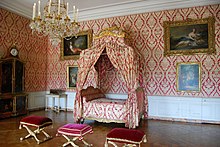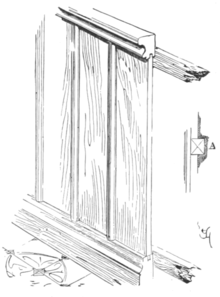Lambris
The or also the lambris ( French ; pronunciation: [lã 'bri:] ; more rarely the lamperie or the lambrie ) denotes a cladding in interior spaces limited to the lower area of a wall surface .
The component can consist of different materials ( wood , PVC , marble , stucco ). The lambris is usually closed at the bottom with a skirting board and at the top with a horizontal (wooden) bar. In the case of paneled designs made of wood or a plastic, panels are attached between the skirting board and the end strip .

Lambris have historically been used for cold insulation, but also to cover damp and mold stains due to rising damp in the masonry , i.e. to increase aesthetics. Depending on the construction, they can also cover pipes or cables belonging to the installation. They also serve to protect against mechanical effects from the back of a chair or kicks. They can be found in public buildings such as schools and courthouses, but also on counters in pubs (for example in Ireland) to protect the counter.
In the case of wood cladding, the panels are usually not attached directly to the wall, but are nailed to a substructure. The individual wooden panels can be attached horizontally or vertically. The marble slabs are glued to the wall with mortar . The stucco cladding is particularly complex, but has a good visual effect. PVC, on the other hand, does not appear to be of high quality, but is very easy to process and is characterized by its high resistance. A PVC sheet is glued to the wall to fix it, similar to laying PVC floors.
history
According to Eugène Viollet-le-Duc , in the Middle Ages Lambris only referred to wall cladding made of boards. The board cladding of roof trusses and ceilings, partly decorated with paintings or carvings, initially bore this name in France. Waist-high wood paneling in the halls and living rooms of the rich population connected to tapestries in the upper wall area, which together served as cold insulation.
At the beginning of the 18th century, the walls of aristocratic rooms could either be plastered and decorated with stucco, paneled to the ceiling with ornate wooden panels or a lambris and textile wall covering . In the early 19th century, lambris and wood paneling were increasingly found in subordinate rooms, the walls of the main rooms were now plastered.

Lambris were found in upscale private buildings at the turn of the 19th and 20th centuries, e. B. in hallways or stairwells. During this time, Linkrusta wall coverings were also popular for the Lambris , a linoleum- like material with plastic ornaments that was glued on. In the simplest variant, the lambris was simply created using a resistant coat of oil paint , which, however, often imitated wood or marble cladding. Coverings made of fabric or oilcloth were also used less often, which were usually fixed to frames made of wooden strips or nailed to strips attached to the wall.
literature
- Friedrich Timm: The modern dictionary of foreign words . Naumann & Göbel, Cologne 2005, ISBN 3-625-10431-8 .
Individual evidence
- ↑ Lambris in Duden ; in French the word is always a masculine.
- ↑ Lambris. In: Lexicon of Art. Architecture, fine arts, applied arts, industrial design, art theory. ISBN 3-363-00286-6 (complete works), Volume 4, EA Seemann Verlag, Leipzig 1992, p. 206 f.
- ^ Henry Havard: Dictionnaire de l'ameublement et de la décoration: depuis le XIIIe siècle jusqu'à nos jours . tape 3 . Paris 1894, Sp. 196-197 ( Gallica ).
- ^ Dictionnaire raisonné de l'architecture française du XIe au XVIe siècle / Lambris - Wikisource. Retrieved August 9, 2020 .
- ^ François Varin: L'histoire d'une maison par ses moulures . In: Continuité . tape 86 , 2000, pp. 54-56 .
- ↑ New Linkrusta patterns for wallcoverings and lambris . In: interior decoration. My home, my pride . tape 16 , 1905, pp. 279–281 , doi : 10.11588 / DIGLIT.7502 ( uni-heidelberg.de [accessed on August 9, 2020]).

